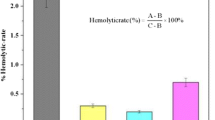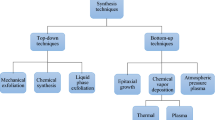Abstract
Graphene is functionalized with amine by NH2 ion implantation at room temperature in vacuum. The reaction is featured by nucleophilic substitution of C–O groups by the ammonia radicals. The presence of N-containing functional groups in graphene is identified by Fourier transform infrared spectroscopy and X-ray photoelectron spectroscopy. N element was successfully introduced to graphene, the atomic ratio of N to C rose to 3.12 %. NH2 ion implanted graphene (G-NH2) is a better hydrophilic material than pristine grahene according to the contact angle experiment. Mouse fibroblast cells and human endothelial cells cultured on G-NH2 displayed superior cell-viability, proliferation and stretching over that on pristine graphene. Platelet adhesion, hemolysis and Kinetic-clotting time were measured on G-NH2, showing excellent anticoagulation, with as good hemolysis as pristine graphene.




Similar content being viewed by others
References
Bermudez E, Mangum JB, Wong BA, Asgharian B, Hext PM, Warheit DB, Everitt JI. Pulmonary responses of mice, rats, and hamsters to subchronic inhalation of ultrafine titanium dioxide particles. Toxicol Sci. 2004;77:347–57.
Pan B, Cui D, Ozkan CS, Ozkan M, Xu P, Huang T, Liu F, Chen H, Li Q, He R, Gao F. Effects of carbon nanotubes on photoluminescence properties of quantum dots. J Phys Chem C. 2008;112:939–44.
Cui D, Tian F, Ozkan CS, Wang M, Gao H. Effect of single wall carbon nanotubes on human HEK293 cells. Toxicol Lett. 2005;155:73–85.
Lam CW, James JT, McCluskey R, Hunter RL. Pulmonary toxicity of single-wall carbon nanotubes in mice 7 and 90 days after intratracheal instillation. Toxicol Sci. 2004;77:126–34.
Wang Z, Ruan J, Cui D. Advances and prospect of nanotechnology in stem cells. Nanoscale Res Lett. 2009;4:593–605.
Liu Y, Yu D, Zeng C, Miao Z, Dai L. Biocompatible graphene oxide based glucose biosensors. Langmuir. 2010;26:6158–60.
Peng C, Hu W, Zhou Y, Fan C, Huang Q. Intracellular imaging with a graphene based fluorescent probe. Small. 2010;6:1686–92.
Sun X, Liu Z, Welsher K, Robinson JT, Goodwin A, Zaric S, Dai H. Nano-graphene oxide for cellular imaging and drug delivery. Nano Res Lett. 2008;1:203–12.
Liu Z, Robinson JT, Sun X, Dai H. PEGylated nano-graphene oxide for delivery of water insoluble cancer drugs. J Am Chem Soc. 2008;130:10876–7.
Hu W, Peng C, Luo W, Lv M, Li X, Li D, Huang Q, Fan C. Graphene based antibacterial paper. ACS Nano. 2010;4:4317–23.
Akhavan O, Ghaderi E. Toxicity of graphene and graphene oxide nanowalls against bacteria. ACS Nano. 2010;4:5731–6.
Yang K, Zhang S, Zhang G, Sun X, Lee ST, Liu Z. Graphene in mice: ultrahigh in vivo tumor uptake and ecient photo-thermal therapy. Nano Lett. 2010;10:3318–23.
Robinson JT, Tabakman SM, Liang Y, Wang H, Casalongue SH, Vinh D, Dai H. Ultrasmall reduced graphene oxide with high near-infrared absorbance for photothermal therapy. J Am Chem Soc. 2011;133:6825–31.
Heo C, Yoo J, Lee S, Jo A, Jung S, Yoo H, Lee YH, Suh M. The control of neural cell-to-cell interactions through non-contact electrical field stimulation using graphene electrodes. Biomaterials. 2011;32:19–27.
Wang K, Ruan J, Song H, Zhang J, Wo Y, Guo S, Cui D. Biocompatibility of graphene oxide. Nanoscale Res Lett. 2011;6:4317–23.
Ryoo SR, Kim YK, Kim MH, Min DH. Behaviors of NIH-3T3 fibroblasts on graphene/carbon nanotubes: proliferation, focal adhesion, and gene transfection studies. ACS Nano. 2010;4:6587–98.
Chang Y, Yang ST, Liu JH, Dong E, Wang Y, Cao A, Liu YF, Wang HF. In vitro toxicity evaluation of graphene oxide on A549 cells. Toxicol Lett. 2010;200:201–10.
Shan C, Yang H, Han D, Zhang Q, Ivaska A, Niu L. Water-soluble graphene covalently functionalized by bio-compatible poly-l-lysine. Langmuir. 2009;25:12030–3.
Luo J, Cote LJ, Tung VC, Tan ATL, Goins PE, Wu J, Huang J. Graphene oxide nanocolloids. J Am Chem Soc. 2010;132:17667–9.
Kim YJ, Abe Y, Yanaglura T, Park KC, Shimizu M, Iwazaki T, Nakagawa S, Endo M, Dresselhaus MS. Easy preparation of nitrogen-enriched carbon materials from peptides of silk fibroins and their use to produce a high volumetric energy density in supercapacitors. Carbon. 2007;45:2116–25.
Hulicova-Jurcakova D, Kodama M, Shiraishi S, Hatori H, Zhu ZH, Lu GQ. Nitrogen-enriched nonporous carbon electrodes with extraordinary supercapacitance. Adv Funct Mater. 2009;19:1800–9.
Yang XQ, Wu DC, Chen XM, Fu RW. Nitrogen enriched nanocarbons with a 3-D continuous mesopore structure from polyacrylonitrile for supercapacitor application. J Phys Chem C. 2010;114:8581–6.
Jurewicz K, Babel K, Ziolkowski A, Wachowska H. Ammoxidation of active carbons for improvement of supercapacitor characteristics. Electrochim Acta. 2003;48:1491–8.
Jurewicz K, Babel K, Pietrzak R, Delpeux S, Wachowska H. Capacitance properties of multi-walled carbon nanotubes modified by activation and ammoxidation. Carbon. 2006;44:2368–75.
Pietrzak R, Jurewicz K, Nowicki P, Babel K, Wachowska H. Nitrogen-enriched bituminous coal-based active carbons as materials for supercapacitors. Fuel. 2010;89:3457–67.
Guo HL, Gao QM. Boron and nitrogen co-doped porous carbon and its enhanced properties as supercapacitor. J Power Sources. 2009;186:551–6.
Lai LF, Chen LW, Zhan D, Sun L, Liu JP, Lim SH, Poh CK, Shen ZX, Lin JY. One-step synthesis of G-NH2 raphene from in situ graphene-oxide reduction and its improved electrochemical properties. Carbon. 2011;49:3250–7.
Singh SK, Singh MK, Kulkarni PP, Sonkar VK, Gracio JJA, Dash D. Amine-modied graphene: thrombo-protective safer alternative to graphene oxide for biomedical applications. ACS Nano. 2012;6:2731–40.
Li DJ, Cui FZ, Gu HQ. F ion implantation induced cell attachment on intraocular lens. Biomaterials. 1999;20:1889–96.
Venkatesan T, Dynes RC, Wilkens B, White AE, Gibson JM, Hamm R. Comparison of conductivity produced in polymers and carbon films by pyrolysis and high energy ion irradiation. Nucl Instrum Meth B. 1984;1:599–604.
Koh SK, Choi KW, Cho JS, Song SK, Kim YM, Jung HJ. Ar+ ion irradiation in oxygen environment for improving wettability of polymethylmethacrylate. J Mater Res. 1996;11:2933–9.
Wang GH, Pan GQ, Dou L. Proton beam modification of isotac-tic polypropylene. Nucl Instrum Meth B. 1987;27:410–6.
Wang GH, Li XJ, Zhu YZ, Liu QS, Hu NX, Gu XS, Wang Q, Yu RX, Wang TJ. Radiation effects on polyethylene and polypropylene by electrons and protons. Nucl Instrum Meth B. 1985;7:497–500.
Licciardello A, Fragala ME, Foti G, Compagnini G, Puglisi Q. Ion beam effects on the surface and on the bulk of thin films of polymethylmethacrylate. Nucl Instrum Meth B. 1996;116:168–72.
Lee HJ, Park J, Yoon OJ, Kim HW, Lee DY, Kim DH, Lee WB, Lee NE, Bonventre JV, Kim SS. Amine-modied single-walled carbon nanotubes protect neuronsfrom injuryina rat stroke model. Nat Nanotechnol. 2011;6:121–5.
Lee W, Parpura V. Wiring neurons with carbon nanotubes. Front Neuroeng. 2009;2:1–3.
Geng DS, Yang SL, Zhang Y, Yang JL, Liu J, Li RY, Sham TK, Sun XL, Ye S, Knights S. Nitrogen doping effects on the structure of graphene. Appl Surf Sci. 2011;257:9193–8.
Grinnel F, Feld MK. Fibronectin adsorption on hydrophilic and hydrophobic surfaces detected by antibody binding and analyzed during cell adhesion in serum-containing medium. J Biol Chem. 1982;257:4888–93.
Lu DR, Park K. Effect of surface hydrophobicity on the conformational changes of adsorbed fibrinogen. J Colloid Interface Sci. 1991;144:271–81.
Zhao ML, Li DJ, Yuan L, Yue YC, Liu H, Sun XL. Differences in cytocompatibility and hemocompatibility between carbon nanotubes and nitrogen-doped carbon nanotubes. Carbon. 2011;49:3125–33.
Akasaka T, Yokoyama A, Matsuoka M, Hashimoto T, Watari F. Thin films of single-walled carbon nanotubes promote human osteoblastic cells (Saos-2) proliferation in low serum concentrations. Mater Sci Eng, C. 2010;30:391–9.
Magrez A, Kasas S, Salicio V, Pasquier N, Seo JW, Celio M, Catsicas S, Schwaller B, Forro L. Cellular toxicity of carbon-based nanomaterials. Nano Lett. 2006;6:1121–5.
Yu X, Cai H, Zhang W, Li X, Pan N, Luo Y, Wang X, Hou JG. Tuning chemical enhancement of SERS by controlling the chemical reduction of graphene oxide nanosheets. ACS Nano. 2011;5:952–8.
Sanchez VC, Jachak A, Hurt RH, Kane AB. Biological interactions of graphene family nanomaterials: an interdisciplinary review. Chem Res Toxicol. 2012;25:15–34.
Motlagh D, Yang J, Lui KY, Webb AR, Ameer GA. Hemocompatibility evaluation of poly (glycerol-sebacate) in vitro for vascular tissue engineering. Biomaterials. 2006;27:4315–24.
Acknowledgements
This study was supported by National Natural Science Foundation of China (51272176, 11075116), National Basic Research Program of China (973 Program, 2012CB933600), and Youth Foundation of Tianjin Normal University (52XQ1204). The Key Project of Tianjin Municipal Natural Science Foundation of China (13JCZDJC33900) supported partly the design and synthesis of graphene and NH2 ion implanted graphene (G-NH2). We appreciate Minsi Li, undergraduate student in School of Chemistry and Materials Science, University of Science and Technology of China, for her kind idea and contribution to synthesis of graphene and NH2 ion implanted graphene.
Author information
Authors and Affiliations
Corresponding author
Rights and permissions
About this article
Cite this article
Guo, M., Li, M., Liu, X. et al. N-containing functional groups induced superior cytocompatible and hemocompatible graphene by NH2 ion implantation. J Mater Sci: Mater Med 24, 2741–2748 (2013). https://doi.org/10.1007/s10856-013-5016-0
Received:
Accepted:
Published:
Issue Date:
DOI: https://doi.org/10.1007/s10856-013-5016-0




